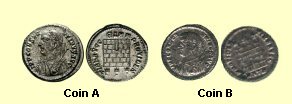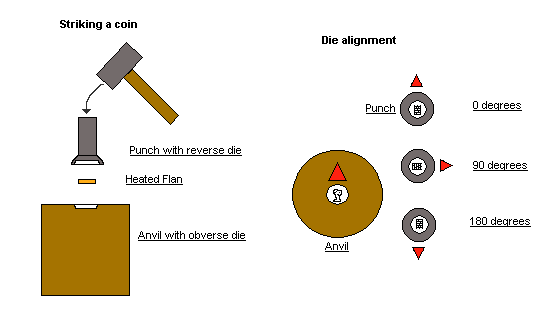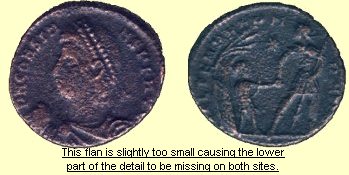One coin, all different.
Due to the production process of Roman coins no two coins look alike and if they do then you may have found a rare die-match or worse a fake coin.

These two coins are in essence the same coin they have the same obverse and reverse legend the same images and same mint and officina. You will give both of them exactly the same reference number, VM (Van Meter) 85, RBC (Roman Bronze Coins) 282 or RIC (Roman Imperial Coinage) VII Heraclea 16. Yet they look completely different. The two coins above are shown at approximately actual size. The fact that the one on the right doesn't look as shiny as the one on the left is due to the scan. There are several things that cause these differences.
- Most coins have different die alignments (the relative position of the obverse and reverse die) the first coin is aligned at 180 degrees and the second at 348 degrees.

- Not all coins are perfectly centered, the flan could have been placed off center so parts of the designs would be missing. The two Constantine coins above are both nearly perfectly centered.

- Not all flans are exactly the same size although difference in width and thickness are usually minimal. And because these coins were struck no two will look alike and will have different protuberances and dents along the outline of the final coin. If a flan is thin then its much more difficult to get good detail because there might not be enough metal to fill in all the details. In our example coin A has been struck on a thicker flan about 1 mm thick and the coin B is slightly thinner at 0,8 mm.

- The dies used to strike the coins are all hand carved by the master carvers of the mint the "scalptores". And because they are carved by different people there are small differences between them.

Most noteworthy differences between these two coin dies are: the eye on the right portrait is much bigger and he has a much more rounded nose, on the reverse the campgate on the right is taller then the one on the left and the O in the word PROVIDENTIAE lies much lower on the left then on the right coin. What I think is extraordinary is that both the obverse portrait and the reverse campgate have exactly the same number of lines on every detail (i.e. exactly the same amount of blocks on the campgate and the lines on the consular robe have different distances and angles but the number of lines is exactly the same indicating to me that they worked from one master example.
- Coins were minted at different locations and each mint
gave its own interpretation to the designs. (for a map with different mints
click here)
- The dies would eventually get worn and would be giving much less
detail to a coin the longer they were used.
- Something could get stuck in either the upper or lower die thus obscuring a piece of detail.
- The die wasn't always struck with same force which would lead to a loss of detail. As you can see there are many many different things that will give each Roman coin a unique look especially in comparison with today's machine produced coins which look exactly the same (an anomaly would be a collectors item and very special, exactly the opposite of ancient coins).